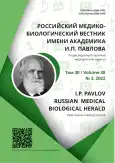Study of Electrophysiological Properties of Atrioventricular Node in Permanent Cardiac Pacing under Influence of Trimetazidine Dihydrochloride
- Authors: Smirnov V.N.1, Staroverov I.N.1, Gridin A.N.1
-
Affiliations:
- Regional Clinical Hospital
- Issue: Vol 30, No 3 (2022)
- Pages: 305-312
- Section: Original study
- URL: https://journals.rcsi.science/pavlovj/article/view/104696
- DOI: https://doi.org/10.17816/PAVLOVJ104696
- ID: 104696
Cite item
Abstract
INTRODUCTION: Dual-chamber cardiac pacing permits to maintain permanent atrial-ventricular synchronization. Physiological sequence of propagation of the impulse from atria to ventricles is provided with an artificial delay analogous to delay of propagation of excitation through the atrioventricular (AV) node of a heathy individual. The delay interval is formed so that to minimize stimulation of the right ventricle. This preserves the left ventricular ejection fraction, reduces the risk of development of the chronic heart failure (CHF) and of atrial fibrillation, and increases functional abilities of the patient. On the other hand, critical increase in the atrioventricular delay leads to pacemaker syndrome: impairment of circulation function, shortness of breath, reduced tolerance to exercise, dizziness, syncopal state. The question of the influence of the permanent electrical pacing on the AV node conduction remains unsolved.
AIM: To study the effect of trimetazidine dihydrochloride on the AV node conduction in conditions of permanent cardiac pacing, to determine the effect of cardiac pacing on the AV node in the studied time period.
MATERIALS AND METHODS: The study involved 86 patients. The AV node activity was assessed by antegrade intraoperative determination of Wenckebach point on the basis of electrocardiography data in 24–48 hours after pacemaker implantation, in 6–8 hours, 7, 14, 9 and 180 days after intake of trimetazidine dihydrochloride and in 7, 14, 21 and 30 days after its cancellation. To compare the extent of influence of the studied drug on the AV node activity, the patients were divided to three groups depending on the basic pathology: group 1 ― patients with the sick sinus node syndrome (n = 38, 44.2%); group 2 ― patients with II degree AV block (n = 25, 29.1%); group 3 ― patients with III degree AV block (n = 23, 26.7%).
RESULTS: Trimetazidine dihydrochloride improved the electrophysiological properties of the AV node in the first and second groups: increase in the mean value of Wenckebach point antegrade in the first group was in total 3.26% (р = 0.022), in the second group 4.68% (р = 0.001). In the third group of patients no improvement was noted, but it should be said that under the action of this drug, in 4 of 23 patients with III degree AV block, antegrade AV conduction appeared (р = 0.236).
CONCLUSION: Trimetazidine dihydrochloride has a positive effect on the AV node activity as early as in 6–8 hours of intake, which reaches maximum in 3 weeks. Cardiac pacing had no effect on AV node within the follow-up period (6 months).
Full Text
##article.viewOnOriginalSite##About the authors
Vasiliy N. Smirnov
Regional Clinical Hospital
Author for correspondence.
Email: osiber82@gmail.com
ORCID iD: 0000-0002-3314-0486
SPIN-code: 7833-8567
Russian Federation, Yaroslavl
Il’ya N. Staroverov
Regional Clinical Hospital
Email: istaroverov@mail.ru
ORCID iD: 0000-0001-9855-9467
SPIN-code: 8011-7176
ResearcherId: М-8174-2014
Dr. Sci. (Med.), Professor
Russian Federation, YaroslavlAleksandr N. Gridin
Regional Clinical Hospital
Email: angrin61@yandex.ru
ORCID iD: 0000-0002-5087-7463
Cand. Sci. (Med.)
Russian Federation, YaroslavlReferences
- Simonenko VB, Steklov VI. Electrical stimulation of the heart: history, current trends and prospects. Clinical Medicine. 2012;(12): 4–10. (In Russ).
- Lamas GA, Lee K, Sweeney M, et al. The Mode Selection Trial (MOST) in sinus node dysfunction: design, rationale, and baseline characteristics of the first 1000 patients. American Heart Journal. 2000;140(4):541–51. doi: 10.1067/mhj.2000.109652
- Ardashev VN, Ardashev AV, Steklov VI. Lecheniye narusheniy serdechnogo ritma. 2nd ed. Moscow: Medpraktika-M; 2005. (In Russ).
- Revishvili ASh, editor. Vremennaya elektrokardiostimulyatsiya. Rukovodstvo. Moscow: GEOTAR-Media; 2009. (In Russ).
- Revishvili ASh, editor. Postoyannaya elektrokardiostimulyatsiya i defibrillyatsiya v klinicheskoy praktike. Moscow: Medpraktika-M; 2007. (In Russ).
- Revishvili AS, Artyukhina EA, Glezer MG, et al. 2020 Clinical practice guidelines for Bradyarrhythmias and conduction disorders. Russian Journal of Cardiology. 2021;26(4): 203–45. (In Russ). doi: 10.15829/1560-4071-2021-4448
- Bokeriya OL, Sergeyev AV. Sovremennoye sostoyaniye problemy odnokamernoy predserdnoy i dvukhkamernoy elektrokardiostimulyatsii u patsiyentov s sindromom slabosti sinusnogo uzla. Annaly Aritmologii. 2012;(3):13–21. (In Russ).
- Bokeriya LA, Revishvili ASh, Dubrovsky IA. Cardiac pacing in Russia in 2010. Journal of Arrhythmology. 2012;(68):77–80. (In Russ).
- Abdulyanov IV, Vagizov II. Current approaches to permanent cardiac pacing. Practical Medicine. 2013;(3):49–55. (In Russ).
- Sanakoyeva VA, Rybachenko MS, Pukhaeva AA, et al. Myocardial biomechanics, intracardiac hemodynamics and endothelial function in patients before and after various types of pacemakers implantation. CardioSomatics. 2019;10(2):56–64. (In Russ). doi: 10.26442.22217185.2.190307
- Steinberg JS, Fischer A, Wang P, et al. The clinical implications of cumulative right ventricular pacing in the multicenter automatic defibrillator trial II. Journal of Cardiovascular Electrophysiology. 2005;16(4):359–65. doi: 10.1046/j.1540-8167.2005.50038.x
Supplementary files







